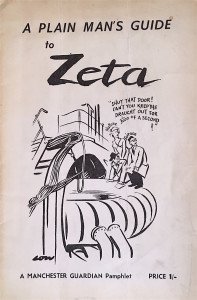 Found – A Plain Man’s Guide to Zeta by John Maddox (Manchester Guardian, 1958). It was in a collection of pamphlets from the library of the late political cartoonist David Low which surfaced in Cambridge. The cover and a few illustrations in its 14 pages are by him. Zeta was a British thermo-nuclear machine, proclaimed here as a ‘sun on earth.’ It was a project from Metropolitan Vickers at the Harwell Atomic Energy Research Establishment that ultimately failed because they could not achieve fusion. There is much on it at Wikipedia, ZETA stood for ‘Zero Energy Thermo-Nuclear Assembly.’ Deuterium from the ocean was a key element according to the pamphlet:
Found – A Plain Man’s Guide to Zeta by John Maddox (Manchester Guardian, 1958). It was in a collection of pamphlets from the library of the late political cartoonist David Low which surfaced in Cambridge. The cover and a few illustrations in its 14 pages are by him. Zeta was a British thermo-nuclear machine, proclaimed here as a ‘sun on earth.’ It was a project from Metropolitan Vickers at the Harwell Atomic Energy Research Establishment that ultimately failed because they could not achieve fusion. There is much on it at Wikipedia, ZETA stood for ‘Zero Energy Thermo-Nuclear Assembly.’ Deuterium from the ocean was a key element according to the pamphlet:
The oceans contain some 330 million cubic miles of water. If we were to extract all the deuterium from this mass of water, and then to burn it as a thermo-nuclear fuel, the energy we should win would be equivalent to 500000000000000000000000 tons of coal. This would last the wold, at its present rate of consumption of all fuels, for about a hundred million million years. This interval of time, it will be noticed, is about thirty thousand times as great as the estimated age of the solar system. Clearly, there is no conceivable way in which we could use up deuterium in a thermo-nuclear furnace in such a way that we could make a perceptible difference to the world’s stock of it.
These facts point to the main significance of deuterium as a fuel. It is so abundant that we cannot conceivably have to worry about supplies of it.

New Acronym ZERO ENERGY TOTALLY AWESOME!
At my old-fashioned grammar school in the early 1960s if it was too wet for rugby we watched suitable educational films. One – it may have been about ZETA – featured the wonders of nuclear energy and the prophecy that it would make electricity so cheap and easily available there’d be no point charging for it.
They don’t make the future like they used to.
I’m guessing “J.C. Maddox” is a slip-up, since the Guardian’s science correspondent at the time was John R. Maddox, previously a theoretical physicist and later notable as twice editor of Nature magazine.
Many thanks DTB — just checked the pamphlet and you are right. He is billed as John Maddox ‘Scientific Correspondant of the Manchester Guardian.’ Will change it.